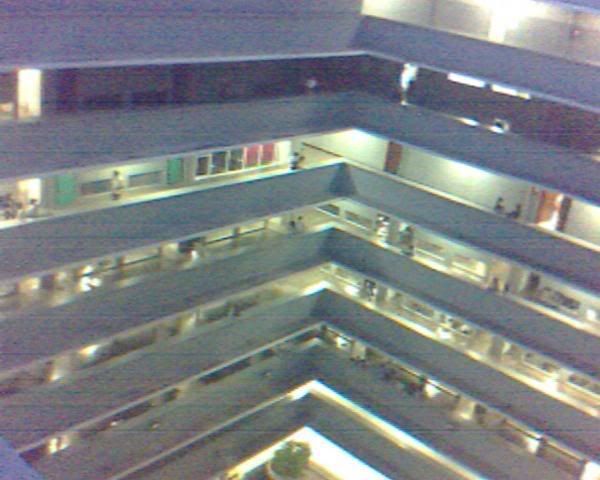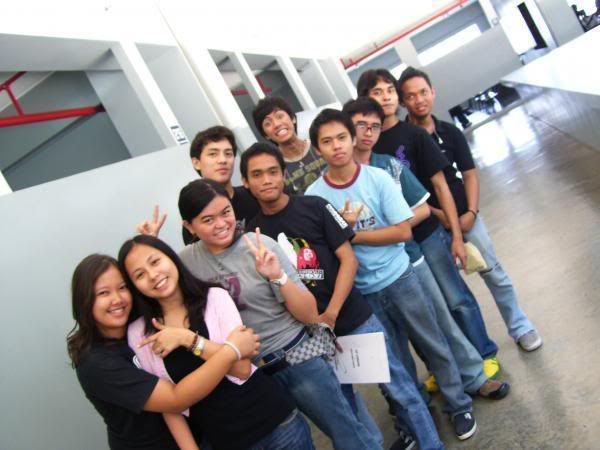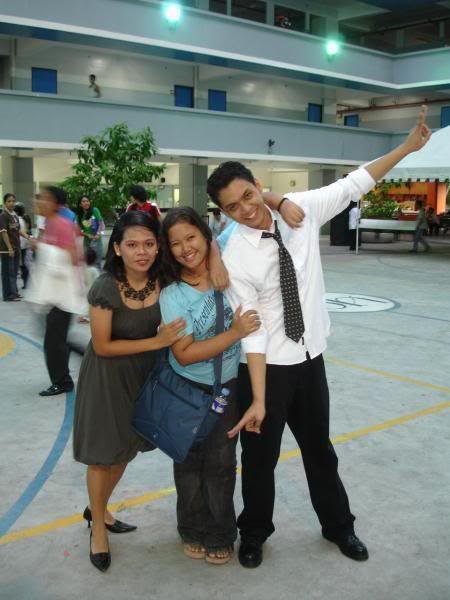Courtesy of Miguel again...
Silliman University
NATIONAL HISTORICAL LANDMARK
A Walk Down Memory Lane
Silliman University was declared as a National Historical Landmark by the National Historical Institute in 2001 during its Centennial celebration. So far, it is the only university whose campus has been declared as a historical landmark and not only for a single building.
Silliman Hall
Built in 1903
Silliman Hall is the first and oldest building on campus. It was built in 1903 and is treasured as a historical landmark in Dumaguete City. It is a bridge to remember the beginnings of the University. It stood the test of time with its four-storey structure whose walls were made of local coral blocks and solid iron posts. The metal sheets used as ceiling were taken from a theater in New York City. Imported timber from the United States West Coast made the rest of the upper floors. It was inaugurated on November 30, 1903. It was a muti-purpose building at its time when it houses classrooms, intern dormitory, dining rooms, study room, chapel, church and teacher's living quarters. It is now a museum.
Katipunan Hall
Built in 1915
Katipunan Hall interior
At night
Katipunan Hall is used to be a Mission Hospital and was built in 1915 by Dr. Langheim, an American missionary doctor, and his wife. The Langheims were the pioneers of Missionary Medical Work of the province. During the second World War, the Mission Hospital was used by the Japanese soldiers as garrison and prison cells. Currently, it houses the Languages department. Many haunting tales fascinate this building – ghost sightings, eerie sounds and happenings. It is even sometimes used as the Horror Booth venue during the university Founder’s Day celebration.
Guy Hall
Built in 1918
The Guy Hall was completed in March 1918 from the donation of William Guy of St. Louis, Missouri. The building was offered in memory of Guy's wife, Kathm Lemoine. Guy Hall was first used as a dormitory for boys. It became an enemy garrison of the Japanese Imperial Army during World War II. Stories said that there is an underground that served as a torture chamber but has now been closed from the public. Another building known for its eerie tales. The building now houses the University Registrar, Admissions Office, and the University Press.
Oriental Hall
Built in 1920
In 1920, the cornerstone of the new girls' dormitory, the Oriental Hall, was laid down by Mrs. Pura Blanco, the first woman graduate of Silliman Institute. In June 1921, the Oriental Hall, the oldest regular dormitory on campus, opened as a permanent residential hall for women with 55 occupants. In 1972, Oriental Hall became a classroom-and-office-building of the College of Business Administration. Although it is currently not occupied, the University plans to convert it back to a dormitory.
Hibbard Hall
Built in 1932
Construction of the Hibbard Hall began in 1932. This building was constructed in honor of Silliman’s founder and first president, Dr. David Sutherland Hibbard and his wife, Mrs. Laura Crooks Hibbard. It then serves as a library and currently it houses the student activity center. It is a favorite hangout for students where they can play pingpong, darts, board games (chess, game of generals, monopoly, etc), read magazines, watch movies, or simply relax at the balcony.
Silliman Church
Built in 1941
War came at the time when building operations for the construction of the new Church in 1941. Aside from this problem, the university had no cash to meet the payroll. There was the problem of materials and equipment, too. Despite this, they did finish it. The cross on the main structure was placed in position during a threatened air raid, and a final picture of the complete work was taken on April 2, 1942, the time when the enemy landings were being made on neighboring islands.
In 1972, when martial law was declared, Silliman was one of the first two universities closed as being the center of student activism in the south. It was also one of the last universities allowed to resume operations after the closure. The school was barricaded by the military while the school paper and campus radio was ordered closed because of being very vocal against the Marcos regime. Despite the threat to life and democracy, martial law did not, however, stop students from gathering and keeping their patriotism aflame. At the basement of the Silliman Church, in a room named the Catacombs, the “secret” campus rendezvous of students continued away from the prying eyes of the military. Catacombs is now the meeting place for the youth for poetry reading, music jamming, or bible worship and other religious activities.
Catacombs: Silliman Church's underground where students secretly gather during Martial Law
photos from flickr
originally posted at Philippine College and University Campuses Thread VI - Page 23 - SkyscraperCity
Results 261 to 270 of 335
Thread: Share your Campus Pics!
-
10-09-2008, 03:31 PM #261
-
10-15-2008, 10:43 PM #262
up up up kO ani nah thread...nice pix mga sis and brO !!!
-
10-15-2008, 11:06 PM #263
yah,im proud to be a sillimanian..naa pa bro.hehehhe

silliman hall..

silliman library..

portal of silliman..

mix na.hehehe

-
10-15-2008, 11:36 PM #264
SHARE SAD NKO AMOA!!!
University of Cebu - Banilad....

MAO NI XA ANG VIEW IF YOU LOOK DOWN AND YOU ARE AT THE 8TH FLOOR. MGA AROUND 6PM NI XA

WA MAN NA KLARO, PERO NAA KOY GI PICTURAN NA MGA HRM NGA MGA CHIEF KUNUHAY

THIS WAS TAKEN YEARS AGO, NAGPA ENROLL MI...

KANI KAY AKO MGA CLASSMATES... CISCO STUDENTS.GAWAS MI ANI SA COM LAB(2ND FLOOR)

ME AND MY FRIENDS...IN OTHER WORDS GROUP OF FRIENDS..NAA MI SA LOBBY SA 2ND FLOOR..NEW BLDG

MGA MANGLILIMOS..BTAW AKO MGA FRIENDS..ITS AROUND 8PM WHEN THIS WAS TAKEN, HULAT MI SA AMO KLAC.

AKO NANG NAG TAKE SA PIC, 8TH FLOOR COMPUTER LAB. NEW LABORATORY, MANA MAN KO SA AMO HANDS ON NA QUIZ, SO NAG PICTURE NLNG KO NILA..^^,

DRI MI GAPAGWAPA WHEN WE WERE STILL 1ST YEARS...PERO 4TH YR NA MI ANI NGA PIC

ROOM 219. AMO ROOM!

AHEM...THE GROUND FLOOR CANTEEN... HEHEHE..OF COURSE, DRI MI EAT.

ME WITH CS FRIENDS NA NING GRADUATE... MAO NI QUADRANGLE...
SO..MAO RA TO..THANKS! SENXA IF NAAY DAGKO KAAU NGA PICS..
-
10-15-2008, 11:46 PM #265
Ganahan kayo ko sa library sa cit..... Ang uc banilad intawon, manghulam kag book, di pwd i-take home kay isa ra to ka book... Ngeee... Tapos ang para sa mga computer related books btaw, isa ra ka shelves. Ang nursing? Sos.... Pati ila books naa sa among shelves..atotzz!
-
10-15-2008, 11:53 PM #266
@ tamse: naa sd mi pic sa inyo skul during our local board exam..
here...


-
10-16-2008, 07:57 AM #267
ai mao buh
 hehehe... ika daghan nman gi gamit ang amo campus para sa mga ingon ana wui... pati sad sa med. tech.... ako ate nagpa uban gud. ^^,
hehehe... ika daghan nman gi gamit ang amo campus para sa mga ingon ana wui... pati sad sa med. tech.... ako ate nagpa uban gud. ^^,
nice lagi pagka edit ang pic.. cute... waa..tatak UC kau oh!
naa man unta sad mi pic nga naa mi anang UC nga logo sa quadrangle... ambot aha na to wui... ^^,
-
10-16-2008, 11:40 AM #268
-
10-16-2008, 04:57 PM #269
@tamse: yah,naa jud inyo logo.nindot sd pagka kuha ky ga circle man gud mi ana after the exam.
-
10-23-2008, 05:59 PM #270University of Cebu - Main Campus, 5th floor Information and Computer Science Dept...
logo sa UC and ako corse na naa sa ako uniform..hehehe


mao ni ako migo na niambak kay ga-uwan..hahaha


Advertisement
Similar Threads |
|



















 Reply With Quote
Reply With Quote



